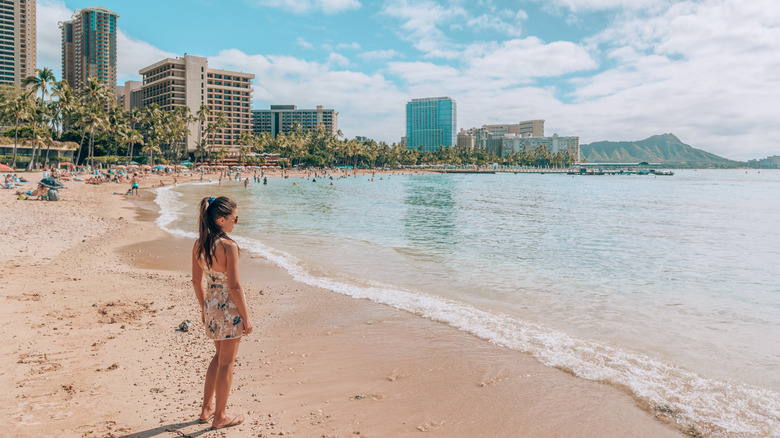The Most Remarkable Attractions That Make A Trip To Hawaii In The Winter So Unique
Most summertime visitors to the Hawai'ian Islands go for the typical touristy activities like snorkeling, sightseeing and surf lessons. But winters in the Aloha State offer up some singular opportunities to get a bit more creative with your vacation planning. To get the lowdown on what you should know when planning a winter getaway, Islands spoke exclusively to Ilihia Gionson, public affairs officer at the Hawai'i Tourism Authority.
"The Hawai'ian Islands are a great place for mindful travelers to visit in the winter," Gionson said. "In addition to the Islands' warm weather and cool trade winds, the diversity in topography and micro-climates throughout the state means visitors can have a multitude of experiences in tropical rainforests, cool regions, hot deserts and sunny resort areas — all within the span of just a few miles." On a typical winter's day on the Big Island, for instance, you could be snorkeling at Kahalu'u Beach in the morning and throwing snowballs atop Mauna Kea (above) in the afternoon.
Gionson also suggests that winter is a great time to get to know the local culture. "We encourage visitors to support our communities by purchasing Hawai'i products, going to the farmers' markets and arts and craft fairs, dining at local restaurants," he said. "It's a great time, for instance, to sample the islands' farm-to-table dining movement, featuring local harvests — avocado and papaya peak in winter."
Cool season activities in Hawaii during the winter
Ever thought of Hawai'i as a college sports fan's paradise? The state hosts major wintertime events, like the Maui Invitational Tournament for basketball fans and the Hawai'i Bowl for football lovers. In the pro category, "The PGA tour kicks off in January, with The Sentry at The Plantation Course at Kapalua," Ilihia Gionson said. And if you'd rather participate than spectate, you can enter the Honolulu Marathon in December.
But the best winter athletes aren't human at all. "Koholā (humpback whale) migration season typically begins in November, with the best times for whale watching from January to March," Gionson explained. "The majestic koholā are best viewed on a guided boat tour, but can also be spotted from the shore." Humpbacks spend summers in arctic waters, then migrate south for mating and calving season in the tropics, with 60% choosing Hawai'i for their romantic antics. You can often spot them breaching and pirouetting in the air from Oahu's uncrowded Yokahama Bay, and the channel between Maui and Lanai.
Another thing to do in winter? Island hop. "We recommend travelers visit more than one island during their stay for varying experiences, as it's an easy 30-45 minute flight to travel inter-island," Gionson said. You can take in the Cherry Blossom Festival on the Big Island, or a big wave surf competition on Oahu's 7-mile Miracle North Shore, then jet over to Lanai for some excellent off-season snorkeling, or Kauai to hike the iconic Kalalau Trail while it's still relatively cool.
What to know before you go to Hawaii in the winter
The same conditions that make winter ideal for watching pro surfers hang ten on 30-foot waves are also the reason you should pack a dose of caution along with your sunscreen. "For beachgoers, the winter season brings dangerous waves, undercurrents and surf conditions — even for experienced, professional surfers and swimmers," Gionson said. "Talk with the lifeguards on duty about the ocean conditions, and always heed warning signs. When in doubt, don't go out, never turn your back to the ocean, and be careful even when walking along the shoreline."
If an active vacay is more your style than a beach day anyway, consider becoming a voluntourist. Gionson's organization is tapping into this white-hot market through its Mālama Hawai'i program — the name translates to "give back" in Hawai'ian. "Visitors can have a more meaningful, enriching experience by working alongside community partners and nonprofits in volunteer efforts, such as planting native trees, restoring Hawai'ian fishponds, and feeding rescued animals at a farm sanctuary," Gionson explained. One great way to volunteer in winter? You can help out those humpbacks during the Hawai'ian Islands Humpback Whale National Marine Sanctuary's annual Sanctuary Open Count. People of all ages from all around the world gather in January, February, and March to pitch in as citizen scientists on this annual whale census drive.
